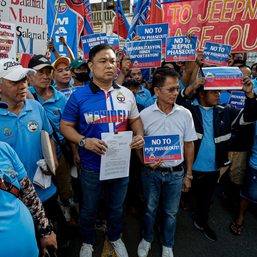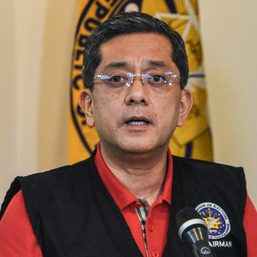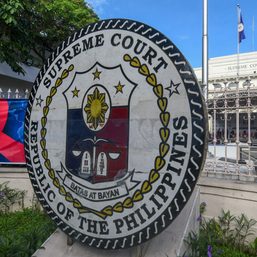SUMMARY
This is AI generated summarization, which may have errors. For context, always refer to the full article.
![[ANALYSIS] Who won in the Anti-Terrorism Act case?](https://www.rappler.com/tachyon/2022/10/anti-terrorism-act-october-15-2022.jpg)
(Note: This speech was delivered by retired Supreme Court senior associate justice Antonio Carpio before the 6th Congress of the National Union of Peoples’ Lawyers held on October 15, 2022.)
I wish to take this occasion to explain who won in the Calleja v. Executive Secretary case involving the constitutionality of the Anti-Terrorism Act (RA No. 11479) which the Supreme Court decided on December 7, 2021. I know many of you, like me, were petitioners in this landmark case, which involves fundamental constitutional rights of the people.
The heart and soul of the Anti-Terrorism Act (ATA) is found in its Section 29, which authorizes the Anti-Terrorism Council (ATC) to order an arrest without judicial warrant, and to extend detention without judicial charge beyond the reglementary 3-day period under the Revised Penal Code (RPC). The rationale for Section 29 was explained by Senator Panfilo Lacson, the principal author of the ATA, during the Senate deliberations, in this manner:
“[W]e asked the law enforcement agents and according to them, the three-day reglementary period is too short to gather enough evidence and to prevent the occurrence of another terrorist act. In fact, in his co-sponsorship speech, Senator Dela Rosa related his own firsthand personal experience wherein he arrested a terrorist suspect but he was forced to release him because he would exceed the three-day reglementary period. Then a few weeks after that, he recognized that same terrorist that he arrested beheading a person in Iraq. When we asked them, they told us that they need at least 14 days to develop a case and to file a strong case for violation of this proposed measure to strengthen the case.”
Defense Secretary Delfin Lorenzana echoed this: “We want a longer detention period so that we can hold the suspect if he is really a terrorist. He cannot commit a terror act. We do not have time to substantiate your charges. You cannot research. You cannot make any allegations. So, 36 hours [under the Revised Penal Code] are too short.”
The clear intent of the ATA, as envisioned by its authors and the government, is to empower the ATC to order the arrest and the extended detention, without judicial charge, of a person violating the ATA so that law enforcers can gather sufficient evidence to make the offense non-bailable when the charge is filed in court.
Thus, Section 29 of the ATA clearly authorized the ATC to order the detention of an accused, without judicial warrant, and to extend the detention without judicial charge, to a total of 14 days.
How did the Supreme Court rule on the constitutionality of Section 29 of the ATA? Did the Supreme Court uphold the authority of the ATC to order the arrest of an offender, and to allow a longer detention period, as obviously envisioned by the authors of the ATA?
The ruling of the Supreme Court on Section 29 is unprecedented in the history of the Court. Despite the clear, unequivocal language and intent of Section 29, the Supreme Court ruled in effect that Section 29 does not mean what it says, and does not say what it means.
The Solicitor General in his comment stated that Section 29 does not authorize the ATC to order the arrest of any person. The Solicitor General interpreted Section 29 as referring to warrantless arrests under Rule 113 of the Rules of Court. In short, the Solicitor General stated that Section 29 is just a reiteration of Rule 113 – which means that Congress labored mightily just to restate what was obviously already part of our legal system for more than 80 years, that is, since at least the effectivity of the 1940 Rules of Court. This interpretation was accepted by the Supreme Court, thus saving Section 29 from being struck down as unconstitutional since the Constitution is very clear that only judges can issue warrants of arrest.
The Court also interpreted that after a warrantless arrest under Rule 113 is made, a 14-day extension of detention can be authorized in writing by the ATC before a criminal case is filed in court. The Court stated that the authority to extend detention can be given only to the officer who made the warrantless arrest under Rule 113. This, in effect, is what Section 29 is all about – an extension by the ATC of the 3-day period to 14 days, counted from the date of the warrantless arrest, to file a criminal complaint but only in cases of warrantless arrests under Rule 113 involving violations of the ATA. This 14-day extension is the only legal effect of Section 29. Indeed, the Supreme Court declared that this extension is the “crux of Section 29.”
However, there is really no justification for extending the detention period following a warrantless arrest under Rule 113. The authors of the ATA wanted a longer detention period, beyond the 3-day period allowed in the RPC, to allow law enforcers to gather strong evidence so that bail could be denied to the arrested person. As you all know, bail is denied if the crime committed is punishable by reclusion perpetua or higher and evidence of guilt is strong.
But in warrantless arrests under Rule 113, by definition evidence of guilt is strong since a person is arrested while committing the offense in the presence of the arresting officer, or the person arrested has just committed an offense and the arresting officer has personal knowledge of such facts or circumstances. Apart from judicial confession, there can be no stronger evidence of guilt for denying bail than the facts and circumstances attending a warrantless arrest under Rule 113. Thus, there is really no need to extend the detention period to 14 days just for law enforcers to gather more evidence in cases involving a warrantless arrest under Rule 113 because by its very nature such a warrantless arrest already involves strong evidence of guilt.
The Court ruled that the ATC, an executive body, cannot order the arrest of any person under Section 29. This was the rule before the ATA was enacted into law, and this is still the same rule after the Court decided on the constitutionality of Section 29.
So who won in this case, the petitioners or the Government? On the heart and soul of the ATA – the empowerment of an executive body – the ATC – to order the arrest of any person, the petitioners obviously won. On the extended detention of a person following a warrantless arrest under Rule 113 for violation of the ATA, I would say it is a draw because if the criminal case is filed within the reglementary period of three days, the accused would as a matter of course still be denied bail and thus would still be in continued detention by the law enforcers. The 14-day extension does not really give law enforcers any material legal advantage.
On the other provisions of the ATA, the Supreme Court struck down as unconstitutional a proviso in Section 4 as void for vagueness as it has a chilling effect on free speech, a part of Section 10 for violating freedom of association, and a part of Section 25 on designation as a terrorist organization for being overbroad. The Court refused to rule on other provisions questioned by the petitioners on the ground that these other provisions could not be challenged facially. The Court made it clear that these other provisions could be challenged as applied in actual cases. And so our work as lawyers is laid out clearly – we have to question the constitutionality of these other provisions as actual cases arise.
We must remain vigilant, prepared to defend at every opportunity the people’s constitutional rights and freedoms whenever they are challenged or infringed. For the price of freedom is eternal vigilance. – Rappler.com
Add a comment
How does this make you feel?


![[The Slingshot] Alden Delvo’s birthday](https://www.rappler.com/tachyon/2024/04/tl-alden-delvo-birthday.jpg?resize=257%2C257&crop=263px%2C0px%2C720px%2C720px)







There are no comments yet. Add your comment to start the conversation.